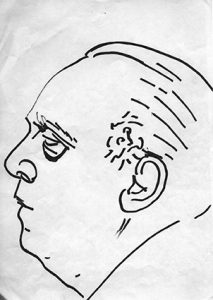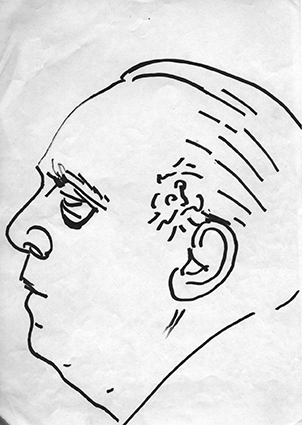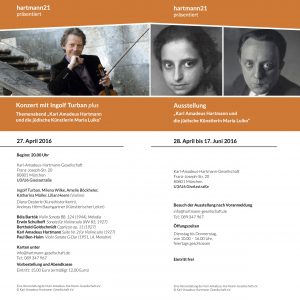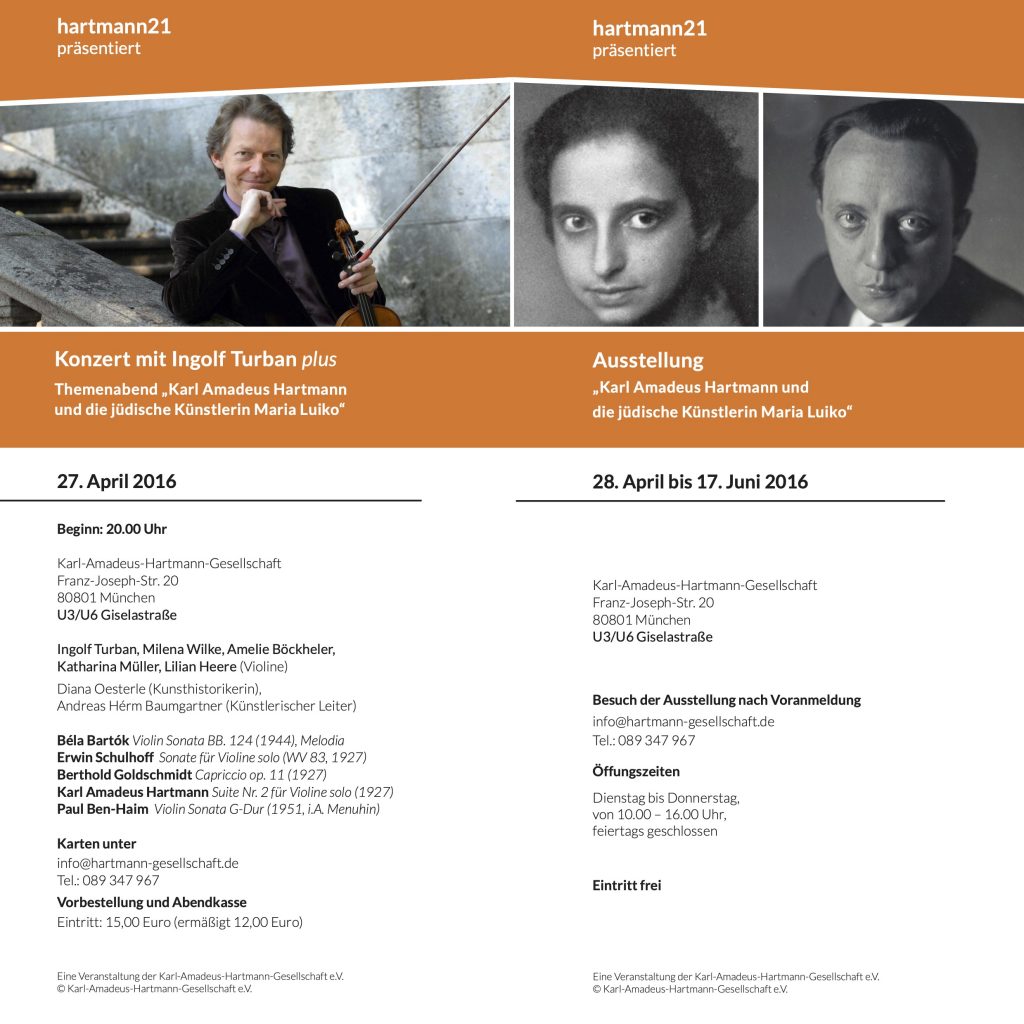Congratulations to the two speakers of this year’s hartmannforum Charlotte Steup and Johanna Bulitta! We are very much looking forward to the respective music-historical and music-analytical lectures on Hartmann’s Concerto funebre. When? 27th November 2024 at 6.30 pm Where? Premises of the Karl Amadeus Hartmann Society / Hartmann Centre in Franz-Joseph-Str. 20 80801 Munich. Further information can be soon found on the homepage. 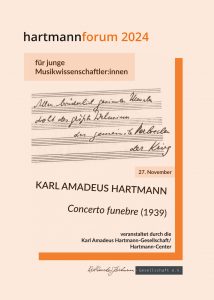
Lecture by Andreas Hérm Baumgartner
As part of the “Bavarian School Music Days” (March 8 to 10, 2018), Andreas Hérm Baumgartner gave a lecture entitled “Klage – Anklage – Gegenaktion. Auf den Spuren von Karl Amadeus Hartmanns musikalischem Widerstand” [“Accusation – Action – Counteraction. On the tracks of Karl Amadeus Hartmann’s musical resistance”]
This lecture and other musicological texts can be found here.
Karl Amadeus Hartmann and the Jewish artist Maria Luiko (Exhibition and concert) // hartmann21
Dedicated to Karl Amadeus Hartmann’s (1905-1963) artistic friendship with the Jewish painter and stage designer Maria Luiko (1904-1941), the event concept consisting of concert, lecture, round table and exhibition on April 27, 2016 not only presents a cross-section of Maria Luiko’s artistic work (on loan from the Jewish Museum Munich), which was brutally ended by her deportation and execution in 1941. It also allows the audience to relive a special moment in Hartmann’s life and œuvre: his encounter with Jewish music. This programme – exemplary through-composed and thus emphatically exposing Hartmann’s intentions – includes works for solo violin by Erwin Schulhoff, Berthold Goldschmidt, Paul Ben-Haim and Karl Amadeus Hartmann. In his isolation as an inner emigrant in National Socialist Germany, Hartmann sought international solidarity with allies in spirit in each of his works, whether through the use of forbidden texts and melodies or with the help of Jewish songs. Especially the use of the Jewish song “Elijahu hanavi” in all compositions written during the years 1933 to 1945 became Hartmann’s lament for the extermination of the Jewish people, but was also representative of the persecution of all opponents of the regime. The first traces of Jewish melismas can already be found in his early work in 1927, the year in which three of the evening’s compositions were written.
The exhibition is supplemented by a selection of Maria Luiko’s letters with the Jewish-Christian bridge builder Schalom Ben-Chorin, who was born in Munich in 1913 and belonged to Maria Luiko’s circle of friends until his emigration to Jerusalem (1935). The selection gives visitors a vivid insight into the everyday life of the Jewish artist in National Socialist Munich (on loan from the Munich City Archive). A short introductory lecture by art historian Diana Oesterle and an in-depth discussion between violinist Ingolf Turban and Andreas Hérm Baumgartner (artistic director hartmann21, conductor) will round off the concert on the opening evening.
An event of the © Karl Amadeus Hartmann-Gesellschaft e.V.
- Category
- Exhibitions
- General
- hartmann21
- Talk
“Hartmann und Henze” – Lecture by Peter Petersen
On October 26, 2013 the renowned Henze researcher Prof. Dr. Peter Petersen gave a lecture for the PROJEKTINSEL HARTMANN-HENZE as part of the “Karl Amadeus Hartmann Year 2013” (2012–2014) entitled “Henze und Hartmann.
Anmerkungen zu einer asymmetrischen Künstlerfreundschaft” [“Notes on an asymmetrical artistic friendship”], in which he traced their personal and artistic friendship with reference to the extensive correspondence between the two composers.
We would like to make the lecture accessible to the public. You can find it under the menu item “Musicological publications” here in the Archival holdings!
- Category
- Talk
“Klänge des Friedens!?” [Sounds of peace!?”] – Lecture by Dieter Senghaas
Under the title “Sounds of Peace” the internationally renowned peace, conflict and development researcher Prof. em. Dr. Dr. Dieter Senghaas (University of Bremen) worked out a a capital, trend-setting presentation for the PROJEKTINSEL HARTMANN-NONO as part of the “Karl Amadeus Hartmann Year 2013” (2012–2014).
The question will be explored to what extent art as a so-called “soft indicator” can contribute to de-escalation or, as an early warning, draw attention to impending undesirable developments in a society’s mental budget.
Especially composers like Hartmann, who are sensitive to socio-political grievances, who use seismographic antennas to perceive developments that are not yet obvious, to detect their potentially fatal dynamics and to deal with them in their art, are particularly suited to this task. Research speaks of the ability of “early warning”.
Years before 1933, Hartmann had already warned in every possible way of the danger of National Socialism for society, humanity and humanism. In each work he dealt with this in a different way, invoking resistance in alliances between cultures, religions and peoples; he pointed out alternatives, drew a different world view. It is also astonishing that in his last work, the “Gesangsszene” for baritone and orchestra, he once again demonstrated the ability of “early warning”: assimilating texts by Jean Giraudoux, he conveys an apocalyptic vision of the end of a civilization drawn into a spiral of death.
The initial dynamic of progress does not only turn into regression, but into decline, into the “evil of the great empires, the deadly evil”. Downfall of the banking world, social structures, nuclear disaster, war and the most deadly evil: that even the “treasure of souls” is lost. The lecture was held on March 20, 2013 in the Munich Stadtmuseum.
Read the complete lecture under the menu item “Musicological publications” here in the Archival holdings!
- Category
- Talk
